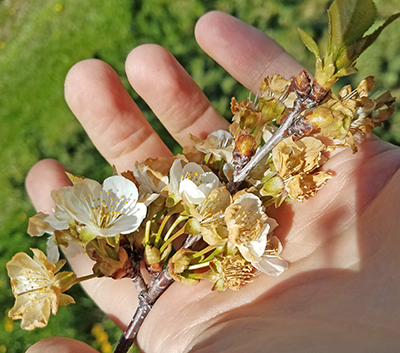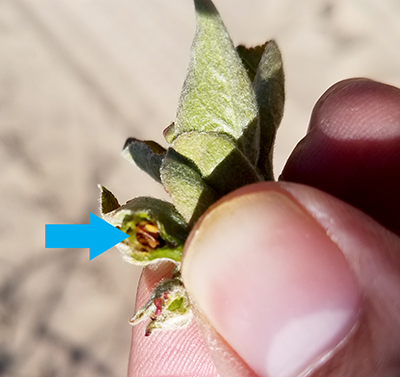West central Michigan tree fruit update – May 9, 2017
Seasonal updates and considerations following frost events on May 8-9 for the west central Michigan tree fruit industry.

Cool, rainy weather last week transitioned into a drier, cooler period that spanned the end of last week as well as the past weekend. Low bee activity was a concern early last week, but good pollinator activity was observed in the warmer afternoon hours on Thursday, Friday and Saturday, May 4-6. However, pollination and fertilization at those cool temperatures is slowed significantly, so growers are looking toward the warmup coming in the middle of the coming week to help move things along.
The cool weather through last week means growing degree-days (GDD) have still been fairly slow to accumulate (Table 1).
|
Table 1. GDDs for west central Michigan since Jan. 1, 2017 | |||
|---|---|---|---|
|
Enviroweather station |
DD base 42 F |
DD base 45 F |
DD base 50 F |
|
269 |
183 |
91 |
|
|
352 |
256 |
142 |
|
|
397 |
292 |
167 |
|
|
362 |
263 |
146 |
|
|
336 |
241 |
129 |
|
While initial forecasts of rain over the weekend that were predicted early last week did not ultimately reach this region, frost that was forecasted arrived on May 8 and 9 as predicted. Strong winds during the day on May 7 transitioned into very calm, clear conditions that night and the early morning hours on May 8 and 9 that were ideal for these frost events to occur. Growers that had frost fans ran them through both nights, as temperatures dropped down into the mid-to-high 20s and low 30s for most of the nighttime and pre-dawn hours.
Sites with wind machines were able to maintain temperatures around 30 degrees Fahrenheit or slightly above for most of both nights, but sites without wind machines experienced varying degrees of below-critical temperatures. Table 2 is summary of minimum temperatures experienced by MSU Enviroweather stations in west central Michigan on May 8-9.
|
Table 2. Minimum temperatures in west central Michigan May 8-9, 2017 | ||
|---|---|---|
|
Enviroweather station |
Minimum temp. (F) May 8 |
Minimum temp. (F) May 9 |
|
Hart |
24.5 |
29.2 |
|
Benona/Shelby |
28.9 |
32 |
|
Elbridge/Hart |
23.9 |
28.3 |
|
Fremont |
27.6 |
27.2 |
|
Ludington |
25.8 |
26.6 |
Extent of damage in the region will continue to unfold in coming days, and is looking to be very dependent on site and duration of these temperatures, as well as the developmental stage of the various fruits during the temperatures. For stone fruit, the critical temperature for 10 percent bud kill right now is about 27-28 F, as sweet cherries, apricots, peaches and tart cherries range anywhere from full bloom to being in the shuck. Damage ranges from light to severe, strongly depending on location. Flowers in some fields are exhibiting extensive damage.

Montmorency tart cherry blossoms with severe frost damage, image collected on the afternoon of May 8.
Apple growth stages are highly dependent on cultivar at this time. Earlier cultivars such as McIntosh and Zestar are at full bloom throughout the region, while cultivars like Honeycrisp are at full pink. Critical temperatures for 10% kill at these stages is around 28 degrees F. Unfortunately, damage in apples appears to be extensive at some sites. Both cultivars in full bloom and cultivars that were in full pink appear to have had extensive damage to the stigma, style, and ovary tissues. Many growers assumed blossoms that were not open would not experience the same degree of damage, but early reports indicate many sites with cultivars that were at pink are registering extensive flower bud kill.

Apple flower bud at full pink with dead stigma, style and ovary. Blossoms that are browned throughout the inside of the bud will not set blooms or fruit.
In light of these frost events, growers in west central Michigan are weighing the benefits of Promalin applications following these events. Michigan State University Extension suggests growers keep the following in mind when considering these applications.
You have until petal fall to get a Promalin application out if you choose. This means we have at least three to four days or more for most of the region, which gives you time to make the appropriate considerations. These necessary considerations are discussed in the next three points.
Promalin will not resurrect dead tissue if the ovary at the base of the pistil is dead. Promalin works best when you have a dead pistil, but have an ovary at the base that is still viable. Promalin tricks the ovary in this situation into thinking that it got fertilized, even though the pistil got fried and this event never actually happened. However, this absolutely requires a living ovary. If the ovary is dead, Promalin will do nothing to save it, and this means it is critically important to scout your flowers in the next couple of days to see the extent of the damage if you plan on using this product. Look at the pistil as well as its base for the ovary. If the ovary is blackened and dead, there is nothing more that can be done for it. However, if you notice a lot of dead pistils with green ovary tissues at the base, Promalin becomes a viable option to increase fruit set in frost damaged blocks.
Promalin is a plant growth regulator (PGR), and these are best applied during warm weather (at least 60 F). It would be wise to wait until at least Wednesday after conditions warm up before applying this product. Applying any PGR below 60 F is not a good practice, as you will see very little effect.
Promalin is best applied with 100 gallons of water per acre. If you do choose to mix it in with your next apple scab cover, a reduced volume rate you might use for an apple scab cover is not ideal for a Promalin cover. For this reason, Promalin is often sprayed as a stand-alone in the tank to ensure adequate water is put out with the product. The Promalin rate is 1 pint per acre.
As with any frost event, time will tell just how we fare in the region. Growers are hoping for the best, and the coming days look to be getting warmer, with nightly lows in the 40s and daily highs in the 60s. No further frosts are forecasted in the next 10 days, so the hope is that this was the last of the frost events for the season.



 Print
Print Email
Email



